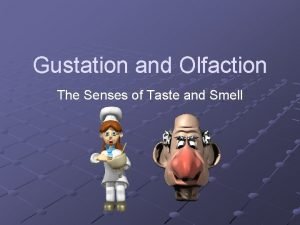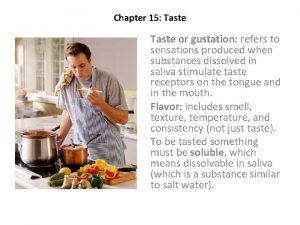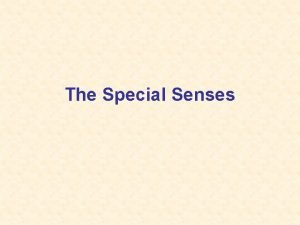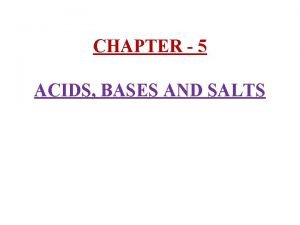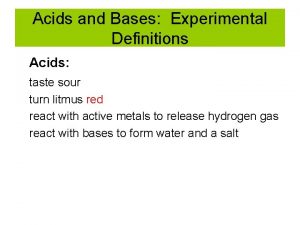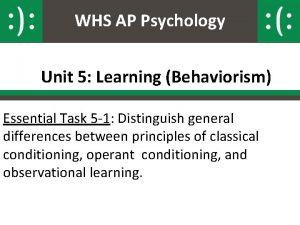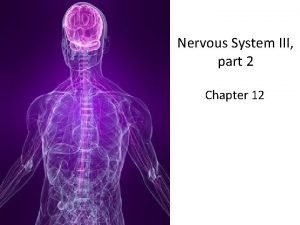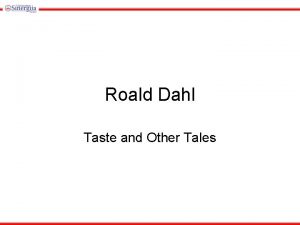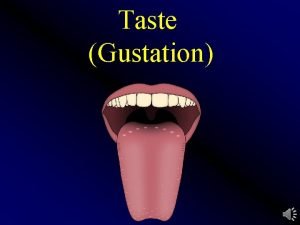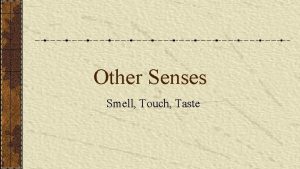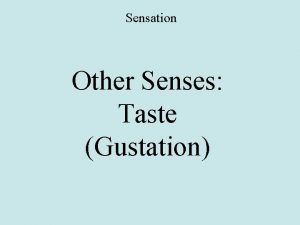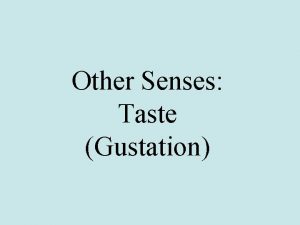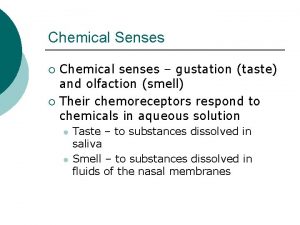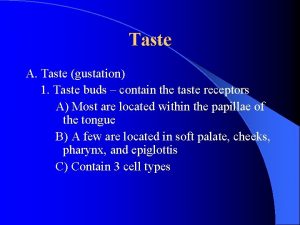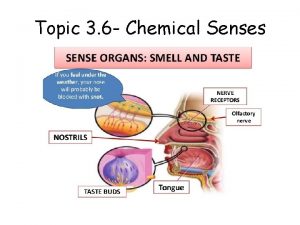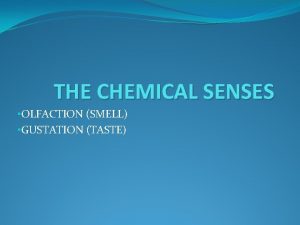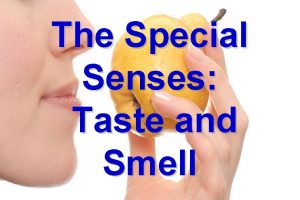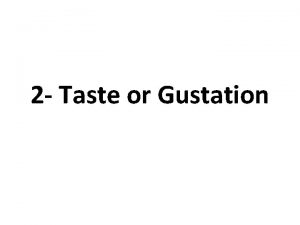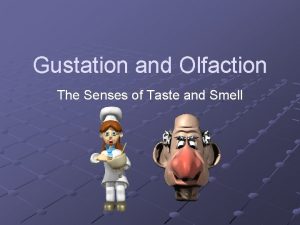CHEMICAL SENSES Chemical Senses Chemical senses gustation taste
















- Slides: 16

CHEMICAL SENSES

Chemical Senses Chemical senses – gustation (taste) and olfaction (smell) ¡ Their chemoreceptors respond to chemicals in aqueous solution l Taste – to substances dissolved in saliva l Smell – to substances dissolved in fluids of the nasal membranes ¡

Sense of Smell Olfactory epithelium l Superior nasal concha l Olfactory receptors ¡ Bipolar neurons ¡ Olfactory cilia l Supporting cells l Basal cells ¡ Olfactory glands ¡

Olfactory Receptors

Physiology of Smell Odorants dissolved in secretion bind to the receptor ¡ G protein is activated ¡ Adenylate cyclase is activated ¡ c. AMP is synthesized from ATP ¡ Na and Ca channels open l Depolarization l Action potential ¡

Olfactory Pathway Olfactory receptor ¡ Olfactory nerves ¡ Synapse with mitral cells l Cells that process odor signals ¡ Olfactory tract ¡ The olfactory cortex ¡ The hypothalamus, amygdala, and limbic system l No synapse on the thalamus ¡

Olfactory Transduction Process Extracellular fluid Na+ Odorant Adenylate cyclase Ca 2+ 1 c. AMP 2 Receptor Cytoplasm Golf GTP GDP GTP 3 GTP 4 ATP c. AMP 5

Taste Buds Most of the 10, 000 or so taste buds are found on the tongue ¡ Taste buds are found in papillae of the tongue mucosa ¡ Papillae come in three types: filiform, fungiform, and circumvallate ¡ Fungiform and circumvallate papillae contain taste buds ¡

Taste Buds

Structure of a Taste Bud ¡ Taste bud consists of three major cell types l Supporting cells – insulate the receptor l Basal cells – dynamic stem cells l Gustatory cells (taste cells) – special epithelial cells ¡ Gustatory hair l Taste pores

Taste Sensations ¡ There are five basic taste sensations l Sweet – sugars, saccharin, alcohol, and some amino acids l Salt – metal ions l Sour – hydrogen ions l Bitter – alkaloids such as quinine and nicotine l Umami – elicited by the amino acid glutamate

Physiology of Taste In order to be tasted, a tastant: l Must be dissolved in saliva l Must contact gustatory hairs ¡ Binding of the food chemical: l Depolarizes the taste cell membrane, releasing neurotransmitter l Initiates a generator potential that elicits an action potential ¡

Taste Transduction ¡ The stimulus energy of taste is converted into a nerve impulse by: l Na+ influx in salty tastes l H+ in sour tastes l The G protein (gustducin) in sweet and bitter tastes

Gustatory Pathway Facial nerve l Anterior 2/3 of the tongue ¡ Glossopharyngeal l Posterior 1/3 of the tongue ¡ Vagus l Pharynx ¡ To the solitary nucleus of the medulla ¡

Gustatory Pathway These impulses then travel to the thalamus, and from there fibers branch to the: l Gustatory cortex (taste) l Hypothalamus and limbic system (appreciation of taste) ¡ Trigeminal nerve provide other information about the food ¡

 Facts about taste
Facts about taste Thanks for your attention doctor
Thanks for your attention doctor Gustation and olfaction
Gustation and olfaction Gustation refers to
Gustation refers to 5 taste senses
5 taste senses Distinguish between general senses and special senses.
Distinguish between general senses and special senses. General senses vs special senses
General senses vs special senses Five basic taste sensations
Five basic taste sensations Taste of neutral substances
Taste of neutral substances Bases taste sour
Bases taste sour Beach side sight
Beach side sight Taste aversion ap psychology definition
Taste aversion ap psychology definition Taste cell
Taste cell Taste and other tales a swim summary
Taste and other tales a swim summary When a choice concerns matters of personal value or taste
When a choice concerns matters of personal value or taste Umami taste foods
Umami taste foods Taste and see that the lord is good
Taste and see that the lord is good


